Spring Cloud Hystrix Circuit Breaker Example
Welcome readers! In this post, we feature a comprehensive article on Spring Cloud Hystrix Circuit Breaker. We will explore an interesting Spring Cloud component known as Netflix Hystrix to implement a circuit breaker while invoking a microservice.
1. Introduction
- Spring Boot is a module that provides rapid application development feature to the spring framework including auto-configuration, standalone-code, and production-ready code
- It creates applications that are packaged as jar and are directly started using embedded servlet container (such as Tomcat, Jetty or Undertow). Thus, no need to deploy the war files
- It simplifies the maven configuration by providing the starter template and helps to resolve the dependency conflicts. It automatically identifies the required dependencies and imports them in the application
- It helps in removing the boilerplate code, extra annotations, and xml configurations
- It provides a powerful batch processing and manages the rest endpoints
- It provides an efficient jpa-starter library to effectively connect the application with the relational databases
- It offers a Microservice architecture and cloud configuration that manages all the application related configuration properties in a centralized manner.
1.1 What is Netflix Hystrix?
Netflix Hystrix or Circuit Breaker is a commonly used component in the Microservice architecture for handling the fault tolerance of a microservice. Following diagram quickly summarizes the circuit breaker pattern.
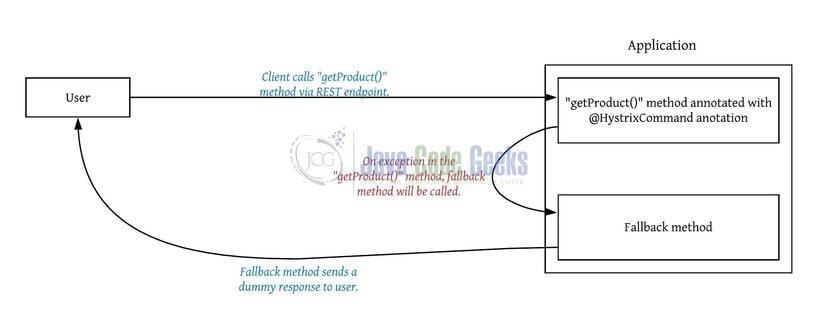
Now, open the eclipse ide and let’s see how to implement this tutorial in spring boot.
2. Spring Cloud Hystrix Circuit Breaker Example
Here is a systematic guide for implementing this tutorial.
2.1 Tools Used
We are using Eclipse Kepler SR2, JDK 8 and Maven.
2.2 Project Structure
In case you are confused about where you should create the corresponding files or folder, let us review the project structure of the spring boot application.
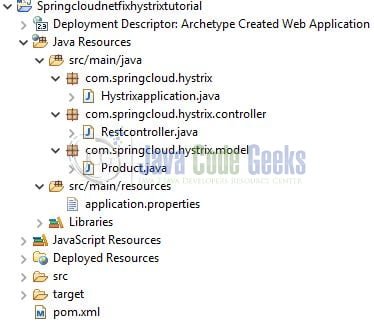
2.3 Project Creation
This section will demonstrate how to create a Java-based Maven project with Eclipse. In Eclipse IDE, go to File -> New -> Maven Project.
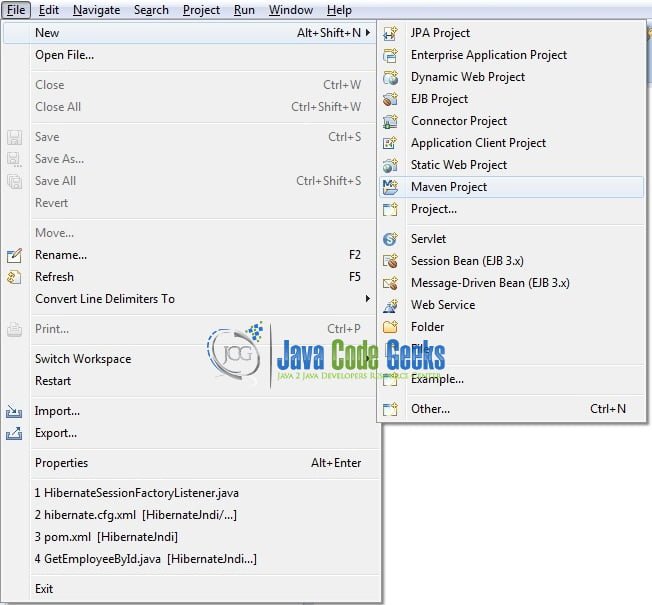
In the New Maven Project window, it will ask you to select a project location. By default, ‘Use default workspace location’ will be selected. Just click on the next button to proceed.
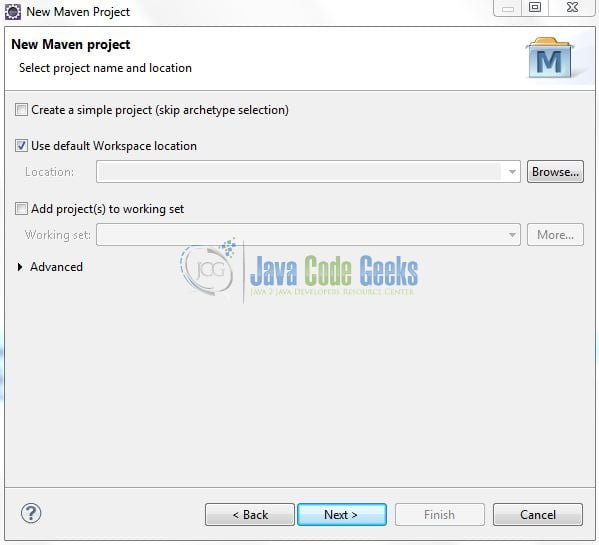
Select the Maven Web App archetype from the list of options and click next.
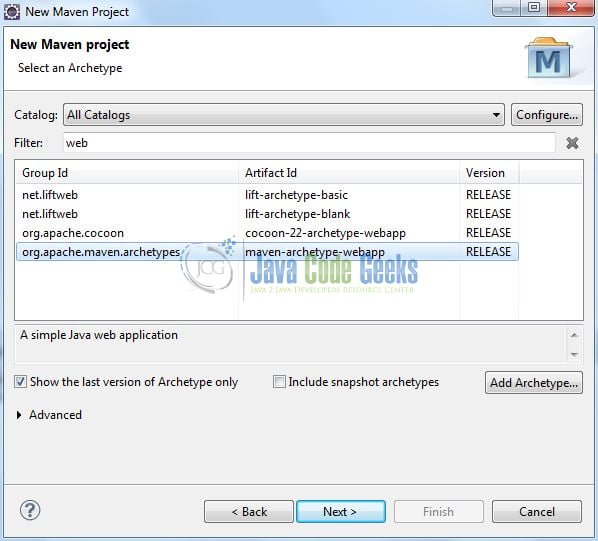
It will ask you to ‘Enter the group and the artifact id for the project’. We will input the details as shown in Fig. 5. The version number will be by default: 0.0.1-SNAPSHOT.
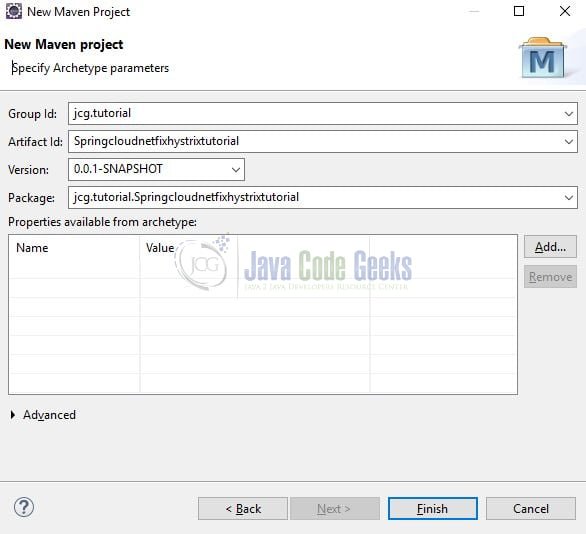
Click on Finish and the creation of the maven project will be completed. If you observe, it has downloaded the maven dependencies and a pom.xml file will be created for the project. Let’s start building the application!
3. Application Creation
Below are the steps involved in developing the application.
3.1 Maven Dependencies
Here, we specify the dependencies for Spring Cloud and Netflix Hystrix. Maven will automatically resolve the other dependencies. The updated file will have the following code.
pom.xml
01 02 03 04 05 06 07 08 09 10 11 12 13 14 15 16 17 18 19 20 21 22 23 24 25 26 27 28 29 30 31 32 33 34 35 36 37 38 39 40 41 42 43 44 45 46 47 48 49 50 51 52 53 54 | <modelVersion>4.0.0</modelVersion> <groupId>jcg.tutorial</groupId> <artifactId>Springcloudnetfixhystrixtutorial</artifactId> <packaging>war</packaging> <version>0.0.1-SNAPSHOT</version> <name>Spring cloud netflix hystrix tutorial</name> <!-- spring boot parent dependency jar --> <parent> <groupId>org.springframework.boot</groupId> <artifactId>spring-boot-starter-parent</artifactId> <version>2.1.3.RELEASE</version> </parent> <!-- To import the spring cloud parent pom as well. --> <dependencyManagement> <dependencies> <dependency> <groupId>org.springframework.cloud</groupId> <artifactId>spring-cloud-starter-parent</artifactId> <version>Greenwich.RELEASE</version> <type>pom</type> <scope>import</scope> </dependency> </dependencies> </dependencyManagement> <dependencies> <dependency> <groupId>org.springframework.boot</groupId> <artifactId>spring-boot-starter-web</artifactId> </dependency> <!-- Dependency to enable Hystrix/Cricuit Breaker in a spring boot application. --> <dependency> <groupId>org.springframework.cloud</groupId> <artifactId>spring-cloud-starter-hystrix</artifactId> <version>1.4.6.RELEASE</version> </dependency> <!-- Java faker is a library that generates fake data for deploying a new project. --> <dependency> <groupId>com.github.javafaker</groupId> <artifactId>javafaker</artifactId> <version>0.18</version> </dependency> </dependencies> <build> <finalName>Springcloudnetfixhystrixtutorial</finalName> </build></project> |
3.2 Configuration File
Create a new properties file at the Springcloudnetfixhystrixtutorial/src/main/resources/ location and add the following code to it.
application.properties
1 | server.port=8181 |
3.3 Implementation Class
Add the following code the main class to bootstrap the application from the main method. Always remember, the entry point of the spring boot application is the class containing @SpringBootApplication annotation and the static main method.
Hystrixapplication.java
01 02 03 04 05 06 07 08 09 10 11 12 13 14 15 16 17 18 19 20 | package com.springcloud.hystrix;import org.springframework.boot.SpringApplication;import org.springframework.boot.autoconfigure.SpringBootApplication;import org.springframework.cloud.client.circuitbreaker.EnableCircuitBreaker;/** * @author yatin-batra * Main implementation class which serves following purpose in a spring boot application: * a. Configuration and bootstrapping. * b. Enables the cache-management ability in a spring framework. */@SpringBootApplication // This annotation boostraps and auto-configure the application.@EnableCircuitBreaker // This annotation enables the circuit breaker for the microservice.public class Hystrixapplication { public static void main(String[] args) { SpringApplication.run(Hystrixapplication.class, args); }} |
3.4 Model Class
Add the following code to the model class.
Product.java
01 02 03 04 05 06 07 08 09 10 11 12 13 14 15 16 17 18 19 20 21 22 23 24 25 26 27 28 29 30 31 32 33 34 35 36 37 38 39 40 41 42 | package com.springcloud.hystrix.model;import org.springframework.stereotype.Component;@Componentpublic class Product { private int id; private String name; private String department; private String price; public int getId() { return id; } public void setId(int id) { this.id = id; } public String getName() { return name; } public void setName(String name) { this.name = name; } public String getDepartment() { return department; } public void setDepartment(String department) { this.department = department; } public String getPrice() { return price; } public void setPrice(String price) { this.price = price; } @Override public String toString() { return "Product [id=" + id + ", name=" + name + ", department=" + department + ", price=" + price + "]"; }} |
3.5 Controller Class
Add the following code to the controller class. Please note, this controller class for testing purpose only and developers can access it via the following link – http://localhost:8181/api/product.
Restcontroller.java
01 02 03 04 05 06 07 08 09 10 11 12 13 14 15 16 17 18 19 20 21 22 23 24 25 26 27 28 29 30 31 32 33 34 35 36 37 38 39 40 41 42 43 44 45 46 47 48 49 50 51 | package com.springcloud.hystrix.controller;import org.springframework.http.HttpStatus;import org.springframework.http.ResponseEntity;import org.springframework.web.bind.annotation.GetMapping;import org.springframework.web.bind.annotation.RequestMapping;import org.springframework.web.bind.annotation.RestController;import com.github.javafaker.Faker;import com.netflix.hystrix.contrib.javanica.annotation.HystrixCommand;import com.springcloud.hystrix.model.Product;@RestController@RequestMapping(value= "/api")public class Restcontroller { static Faker faker= new Faker(); @GetMapping(value= "/product") @HystrixCommand(fallbackMethod= "defaultResponse") public ResponseEntity<Product> getProduct() { Product item = new Product(); item.setId(1001); item.setName(faker.commerce().productName()); item.setDepartment(faker.commerce().department()); item.setPrice(faker.commerce().price()); // Throwing an error for illustrating that the microservice is down and the fallback method will be called for sending a dummy response. if(item.getId() == 1001) { throw new RuntimeException(); } return new ResponseEntity<Product>(item, HttpStatus.OK); } // When we define a fallback-method, the fallback-method must match the same parameters of the method where you define the Hystrix Command // using the hystrix-command annotation. public ResponseEntity<Product> defaultResponse() { System.out.println("You are seeing this fallback response because the underlying microservice is down or has thrown an error!"); Product fallbackItem = new Product(); fallbackItem.setId(90009); fallbackItem.setName("Dummy Name"); fallbackItem.setDepartment("Dummy Department"); fallbackItem.setPrice("0.00"); return new ResponseEntity<Product>(fallbackItem, HttpStatus.INTERNAL_SERVER_ERROR); }} |
4. Run the Applications
As we are ready with all the changes, let us compile the spring boot project and run the application as a java project. Right click on the Hystrixapplication.java class, Run As -> Java Application.
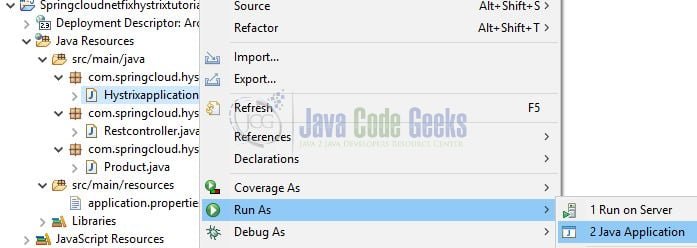
Developers can debug the example and see what happens after every step. Enjoy!
5. Project Demo
Now hit the following application url on your favorite browser and developers will see the output page.
http://localhost:8181/api/product

That is all for this tutorial and I hope the article served you whatever you were looking for. Happy Learning and do not forget to share!
6. Spring Cloud Hystrix Circuit Breaker – Conclusion
In this section, developers learned how to create a circuit breaker application. Developers can download the sample application as an Eclipse project in the Downloads section.
7. Download the Eclipse Project
This was an example of implementing the Spring Cloud Hystrix Circuit Breaker.
You can download the full source code of this example here: Spring Cloud Hystrix Circuit Breaker Example


